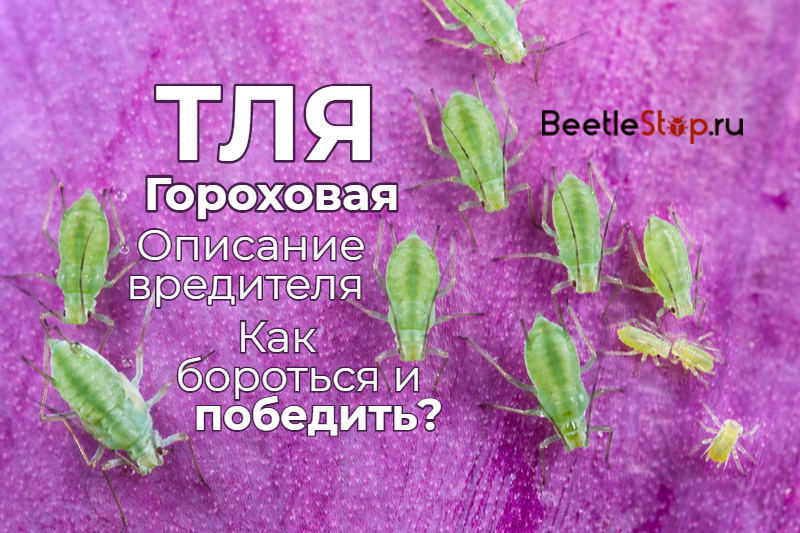Pea aphid: how phytophages capture territory, pest control methods
Aphids are a superfamily of insects that feed on plant sap. Described 4 thousand species of phytophages, many of which are dangerous pests of crops. Pea aphids feed on legume crops. Green or brown individuals hide on the underside of leaves and pods. In one season, 10-15 generations of aphids change. The method of propagation of pea pests is parthenogenesis. Females without mating give birth to 100-150 larvae. Phytophages not only suck plant juice, but also spread various viruses. As a result, the yield and quality of legumes is significantly reduced.

View description
Pea aphids (Acyrthosiphonpisum) belong to the family of real aphids. The phytophage lives and feeds on legumes, damaging young leaves and ripe pods. Aphids are secreted by a large body size - 4-5 mm. The main color is green, dull, but some individuals are brown or pink. In the photo pea aphids of various shades. Dark colors appear in late summer. Antennae longer than body, composed of six segments. Near the base they are green, and at the end they are dark. Aphids have a proboscis for piercing leaves and sucking out juice. The tail is xiphoid, limbs thin and long.
Propagation Features
Faced with an attack by a pest on their site, gardeners are wondering if pea aphids have wings? Can it settle on a large territory? The life cycle and development of the phytophage has its own characteristics.
In the species Acyrthosiphonpisum, 4 types of individuals are distinguished:
- Founders or wingless virgins. They appear in spring from eggs. Without mating and fertilization, females give birth to up to 100 larvae. Reproduction occurs by parthenogenesis. Aphids live in large colonies on fodder plants.
- Winged Virgin. In the third, sometimes in the second generation, female pea aphids with wings appear. By the time they are born, the plant becomes stiff, and the colony grows. It is necessary to resettle and search for new food sources. New females stand out for their large size (5-6 mm) and the presence of transparent wide wings.
- Normal females - appear by the end of summer, to continue the genus they need fertilization. Lay eggs on the basal zone of alfalfa, clover and other perennial legumes. Eggs laid in the fall are oval. At first they are green, then turn black.
- Normal males - are born in early autumn, fly to the host plant to fertilize the females.
Information. By the method of viviparous parthenogenesis, each female reproduces 4-10 larvae per day. During her life, she leaves 100-150 daughters.
Distribution area
Pea aphids live everywhere where legumes are grown. Insects are found all over the world, they are cosmopolitan. Aphid is a pest of crops in Europe, Siberia, Kazakhstan, the Mediterranean, North Africa and America. In Russia, it lives in territories up to 67 ° north latitude.
Pest Life Cycle
From the overwintered eggs in spring, larvae (nymphs) appear. Outwardly, they look like adult aphids, only small in size. Hatching larvae feed on perennial grasses on which eggs were laid. It is mainly clover, alfalfa and winter legumes.With the advent of winged female settlers, pests move to annual plants:
- peas;
- soybeans;
- lentils
- Vika;
- Beans
The nymph needs four molts to reach adulthood, then the imago proceeds to parthenogenesis. 8-10 days are enough for the development of one generation, so the colony grows exponentially. The main harm occurs in the middle of summer - June – July. Favorable conditions for development are warm weather with moderate humidity. In hot weather or in constant rains, the number of aphids is reduced.
Information. Aphid development is incomplete; pupal stage is absent. The full life cycle takes 1 year, with the egg stage lasting 8-10 months.
Pests prefer to eat at the top of plants. They cause significant damage during the setting of buds and flowering. The fertility of females is especially high during this period. Aphids and its many offspring live and eat together. After their punctures and exhaustion of the juice, the leaves curl, the pods are deformed, and productivity decreases. With the advent of winged females, the settlement of legume grasses begins. By autumn, when the temperature drops and daylight hours are reduced, heterosexual individuals appear on them. Males and females after mating leave eggs, not more than 10 pieces.
Attention. In the southern regions, aphid development is observed from March to November, during which time more than 20 generations are replaced.
Ways to deal with pea aphids
Pest destruction occurs in several ways:
Agrotechnical measures
Crops of perennial grasses are planted at a considerable distance from annual legumes. Winged females cannot fly long distances. The cultivation of early peas and early sowing is recommended. In this case, the plant is ahead of the aphid in development, they are less vulnerable to the effects of the pest.
Chemical method
The treatment of crops with insecticides is recommended before flowering. Aphid colonies have not yet reached a maximum, the likelihood of destroying beneficial insects is also reduced. Among the most effective drugs:
- Karbofs 0.2%;
- Chlorophos 0.4%;
- Phosphamide 0.2%.
Tip. You can destroy the pest by treating the infusion of onion peel (200 g of product per 10 l of water).
Pea aphids have many natural enemies: predatory insects, birds, parasites, fungal infections. Especially worth noting are the flies and ladybugs. Weather conditions significantly limit the development of the phytophage. Insects stick weakly to the plant, so during heavy rains and strong winds they fall in large numbers to the ground.

